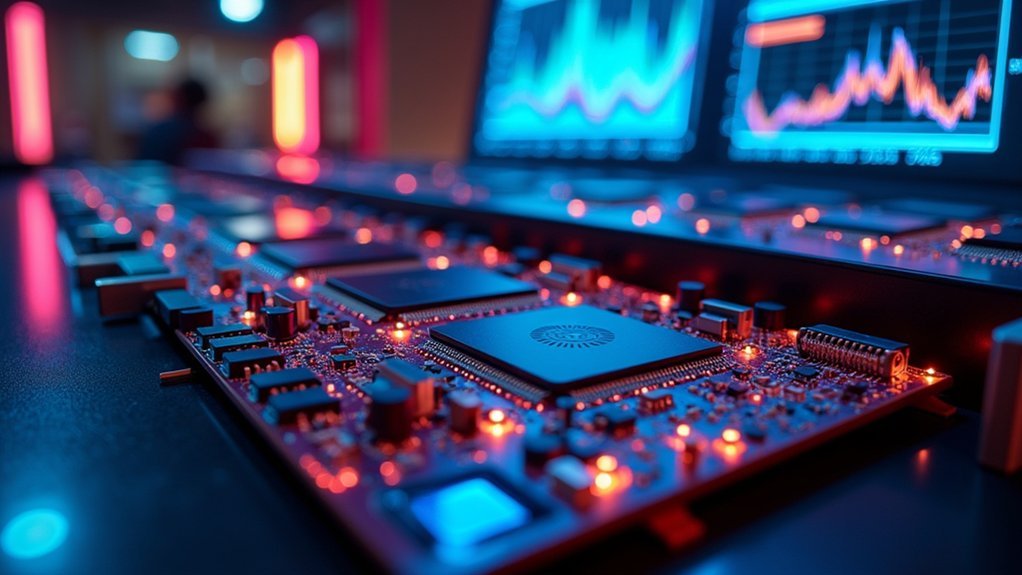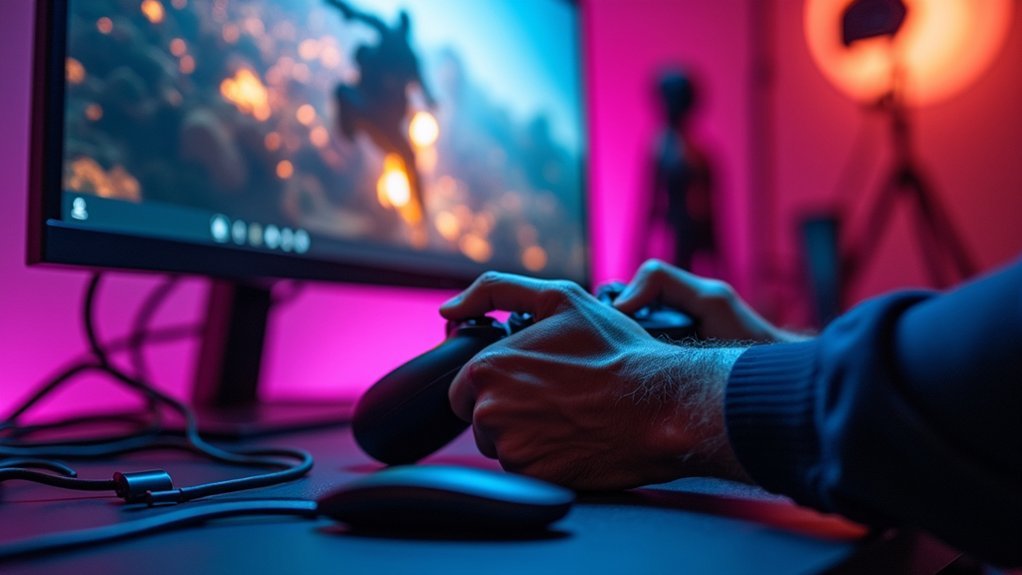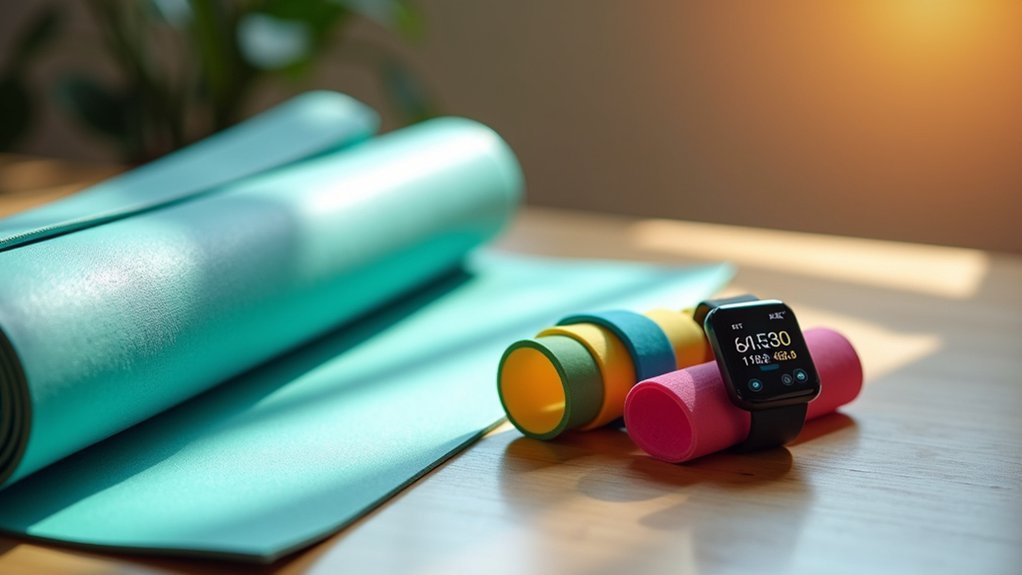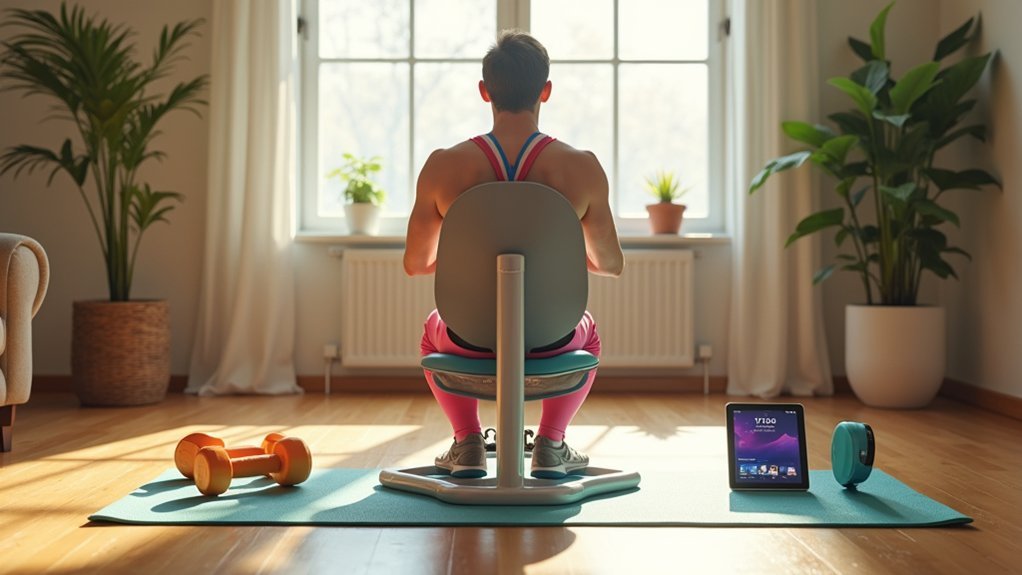To slash motion tracking latency, you’ll get the best results by implementing high-speed video capture with global shutters, using motion prediction algorithms that anticipate movements, deploying event-based vision sensors for microsecond resolution, optimizing hardware-software integration, strategically placing lightweight markers, accelerating processing with GPUs or FPGAs, and fusing multiple sensor types. These techniques can reduce latency from milliseconds to microseconds, dramatically improving responsiveness in your real-time applications. Discover how each method can be tailored to your specific tracking needs.
High-Speed Video Capture for Precise Latency Measurement

When measuring motion tracking latency with precision, high-speed video capture stands as the gold standard tool for developers and researchers. With capabilities reaching 100,000 fps, these cameras allow you to identify exactly when movements occur and responses begin.
High-speed video capture reveals motion tracking latency with microscopic precision, giving developers visibility into the previously invisible.
You’ll need high-performance equipment—cameras with at least SXGA resolution (1280 x 1024) paired with systems featuring Core i7 processors and SSDs. Implementing electronic triggers ensures you capture exactly the event you need without wasting storage on irrelevant footage.
For best results, consider multi-camera setups that capture synchronized footage from different angles. The frame-by-frame analysis these systems enable lets you pinpoint latency issues to the millisecond.
Today’s compact high-speed cameras offer portability without sacrificing performance, making field testing practical. Just remember that higher frame rates generate massive data files, so plan your storage accordingly.
Motion Prediction Algorithms That Anticipate User Movement
While high-speed cameras help measure latency, motion prediction algorithms actively reduce it by anticipating what users will do next. Goal-oriented models understand the intentional nature of human movement, enabling your system to predict where users are heading before they arrive.
You’ll find Kalman filters particularly effective for low-complexity tracking scenarios, using recursive Bayesian estimation to forecast positions based on velocity and acceleration.
For more demanding applications, consider ByteTrack, which excels at handling multiple objects in dynamic environments. Real-time processing requires substantial computational resources to maintain smooth tracking performance without introducing additional latency.
Combining deep learning with traditional methods gives you the best results—CNNs extract rich features while Kalman filters provide error correction.
This hybrid approach balances computational demands with performance, helping you overcome challenges like occlusion and varying object scales that typically increase tracking latency.
Event-Based Vision Sensors for Asynchronous Tracking
Unlike traditional frame-based cameras that capture entire images at fixed intervals, event-based vision sensors monitor pixel-level changes and report only when they detect intensity variations. This neuromorphic approach mimics biological vision, delivering asynchronous data with sub-microsecond temporal resolution.
You’ll gain significant latency reductions by implementing systems like Asynchronous Multi-Object Tracking (AEMOT), which processes raw events individually rather than waiting for complete frames. The AEB Tracker and Field of Active Flow Directions components help identify and validate objects in motion with remarkable efficiency. Event cameras provide high temporal resolution while eliminating motion blur commonly found in conventional camera systems.
These sensors excel in dynamic environments and varying lighting conditions thanks to their high dynamic range. By leveraging the spatio-temporal sparsity of events, you can achieve up to 20x reduction in computational complexity while maintaining—or even improving—tracking accuracy.
Hardware-Software Co-optimization Techniques
Hardware-software co-optimization offers one of the most effective approaches to reduce motion tracking latency by aligning algorithm design with specialized processor architectures.
You’ll achieve significant performance gains by streamlining data flow paths between sensors, memory, and processing units to eliminate bottlenecks that typically slow tracking systems.
Implementing parallel processing architectures lets you distribute computational loads across multiple cores, enabling simultaneous handling of different tracking tasks and dramatically cutting overall response time.
The Application-Specific Instruction-Set Processor architecture is particularly well-suited for motion tracking applications as it provides ASIP architecture tailored for efficient matrix computations required in real-time gesture recognition.
Hardware-Software Co-optimization Techniques
When engineering systems for minimal motion tracking latency, the integration of hardware and software optimization creates powerful synergies that standalone approaches can’t achieve.
You’ll find significant performance gains through unified frameworks that consider both components simultaneously rather than optimizing them separately.
Implement Pareto optimization to identify the ideal balance between latency, power consumption, and physical footprint.
Consider using runahead execution techniques to mask memory latency during irregular access patterns.
For thorough improvements, develop accurate latency models that account for both hardware capabilities and software execution patterns. These models can be enhanced by incorporating bit-stream sources for processing, similar to stochastic computing systems that provide hardware-efficient solutions.
Design your architecture with scalability in mind, allowing your system to maintain low latency even as complexity increases.
These co-optimization approaches will consistently outperform techniques that tackle hardware and software in isolation, delivering the responsive motion tracking experience users demand.
Data Flow Streamlining
Streamlining data flow across the entire motion tracking pipeline offers perhaps the most significant opportunity to slash latency while maintaining tracking fidelity.
You’ll see immediate improvements by implementing specialized neural networks like CNNs and RNNs that extract features efficiently in real-time.
Leverage algorithms such as FairMOT and MDNet to enhance tracking accuracy while reducing computational demands.
Don’t overlook data compression techniques that speed up transfer times between pipeline stages.
Implementing predictive modeling helps anticipate motion patterns, allowing your system to pre-process likely future states.
For maximum impact, push processing closer to data sources through edge computing implementations.
This dramatically reduces transmission distances and prioritizes critical data packets.
When combined with optimized network architecture, you’ll create a streamlined data pipeline that delivers responsive, high-fidelity motion tracking with minimal latency.
Integrating Kalman filters into your tracking system can effectively mitigate occlusion issues and maintain object continuity even when visibility is temporarily lost.
Parallel Processing Architecture
While streamlined data flow creates a solid foundation, parallel processing architecture turbocharges your motion tracking system’s performance. You’ll see dramatic latency reductions by leveraging hardware-software co-optimization techniques. NVLink technology provides high-speed communication between multiple GPUs, significantly reducing data transfer time for complex motion tracking workloads.
| Architecture | Benefit | Performance Gain |
|---|---|---|
| CUDA Cores | Massive parallelization | Up to 5x speedup |
| Tensor Cores | Accelerated matrix math | 48 fps frame rates |
| Multi-Threading | Tracker-detector collaboration | Reduced processing time |
| Distributed Systems | Balanced workload distribution | Enhanced scalability |
Implement hybrid approaches that combine fast trackers with accurate detectors for robust performance without sacrificing speed. Make certain your software framework is optimized for parallel environments to fully utilize high-bandwidth memory and prevent data transfer bottlenecks. These co-optimization techniques are essential for real-time applications like autonomous vehicles or medical imaging where milliseconds matter.
Optimized Camera and Marker Systems for Faster Response
You’ll dramatically cut tracking latency by selecting high frame rate cameras that can capture rapid movements at 120fps or higher.
Position your markers strategically on the most tracked body parts, ensuring they remain visible to multiple cameras throughout the motion sequence.
Supplement your hardware setup with structured light patterns like those used in Lumitrack technology to enable precise position detection even during fast movements.
Minimizing filtering and buffering in your sensor system is crucial as excessive filtering can introduce significant delays that compromise the responsive experience users expect.
High FPS Hardware Selection
To dramatically reduce motion tracking latency, selecting the right high-speed hardware forms your foundation for success.
Choose cameras that balance frame rate with resolution—higher fps may require lower resolution to maintain peak performance. Look for models with global shutter technology to eliminate distortion in fast-moving scenarios.
Consider cameras like the Pharsighted E9 100S, which captures up to 326,000 fps for ultra-precise tracking. Many professionals rely on the Iron 4502 camera which captures up to 2436 frames per second for detailed motion analysis. Confirm your system includes short exposure times to minimize motion blur and advanced sensor technology for reliable synchronization with markers and triggers.
When integrating your hardware, prioritize seamless data transmission through high-speed frame grabbers.
Multi-camera setups require precise timing and synchronization. Your marker system should feature robust materials and customizable configurations to meet your specific tracking requirements while maintaining consistent data quality.
Strategic Marker Placement
Precise marker placement stands as the cornerstone of low-latency motion tracking systems. Position your markers on bony prominences to minimize soft tissue movement and reduce motion artifacts that create processing delays.
Optimize your setup by placing markers where they’ll remain visible to multiple cameras simultaneously. This enhances triangulation speed and prevents costly data loss from occlusions. For best results, maintain symmetrical patterns across the body and consistent protocols between sessions. Document all marker locations meticulously to ensure reproducibility across multiple tracking sessions and subjects.
Consider marker size carefully—smaller, lightweight options reduce wobble while maintaining visibility. Select high-reflectivity materials matched to your camera system’s wavelengths for faster detection.
When facing complex movements, implement model-based optimization algorithms that refine marker positions based on inverse kinematics. These adjustments greatly reduce tracking errors and processing time, delivering the responsive experience your application demands.
Real-Time Processing Through GPU and FPGA Acceleration

Achieving the lowest possible latency in motion tracking requires sophisticated hardware acceleration, which is where GPUs and FPGAs shine as game-changing technologies.
You’ll see dramatic improvements using NVIDIA’s CUDA framework, which can deliver 40-fold performance gains over CPUs in vision processing algorithms. For peak efficiency, consider NVIDIA Reflex, which dynamically balances CPU and GPU workloads while keeping clock speeds high even when CPU-bound. Competitive gamers benefit from Reflex’s ability to reduce system latency significantly, giving them crucial advantages in fast-paced scenarios.
FPGAs offer complementary benefits through customization and lower power consumption. Their reconfigurability makes them ideal for specific tracking tasks that need immediate feedback.
For supreme performance, implement a hybrid architecture that distributes tasks effectively between both technologies. GPUs can handle intensive parallel computations while FPGAs process time-sensitive data, creating a flexible, scalable system that minimizes latency across your entire tracking pipeline.
Multi-Sensor Fusion for Robust Low-Latency Tracking
Multi-sensor fusion represents the cornerstone of modern low-latency tracking systems, combining data streams from diverse sensor types to overcome the limitations inherent in single-sensor approaches.
By integrating cameras, lidars, radars, and ultrasonic sensors, you’ll achieve markedly improved tracking accuracy while reducing system vulnerability to environmental challenges.
The most effective fusion implementations utilize Kalman filters for probabilistic state estimation alongside machine learning models that identify complex patterns in multi-modal data. This approach particularly enhances performance in autonomous driving applications where feature-level fusion techniques show superior real-time capabilities.
You’ll need to prioritize sensor calibration and data alignment to minimize systematic errors and guarantee temporal synchronization.
For applications demanding ultra-low latency, implement novel delay compensation techniques and moving horizon estimation.
These approaches, particularly successful in autonomous racing scenarios, can dramatically reduce perception software latency while maintaining the robustness advantages of multi-sensor systems.
Frequently Asked Questions
How Does Tracking Latency Affect Competitive Gaming Performance?
Tracking latency reduces your competitive gaming performance by lowering accuracy, decreasing scores, slowing reactions, and hampering target acquisition. Even a 10ms reduction improves your shooting accuracy by 0.8% and boosts points by 1.2.
What Latency Levels Are Acceptable for Medical Applications Like Surgery?
For medical applications like surgery, you’ll need ultra-low latency of under 100ms ideally. You should aim for 20-50ms in critical procedures to guarantee your movements translate in near real-time for patient safety.
Can Latency Compensation Techniques Work With Older Hardware Systems?
Yes, you can use latency compensation techniques with older hardware, but you’ll face limitations. Your success depends on software compatibility, processing power constraints, and whether your aging drivers properly support latency reporting features.
How Do Environmental Factors Like Lighting Impact Tracking Latency?
Poor lighting increases your tracking latency as sensors struggle to detect markers. You’ll experience better performance in bright, stable environments where high contrast helps your system process movement data more quickly.
What Are the Power Consumption Tradeoffs for Low-Latency Tracking Solutions?
You’ll face tradeoffs with low-latency tracking: higher processing speeds consume more power, while energy-saving methods like reduced sampling or data mules increase latency. Consider hardware efficiency and application-specific needs when balancing these competing requirements.
In Summary
You’ve now discovered the seven critical methods to minimize motion tracking latency. By implementing high-speed capture, prediction algorithms, event-based sensors, hardware-software optimization, enhanced camera systems, GPU/FPGA acceleration, and multi-sensor fusion, you’ll dramatically improve your tracking performance. Don’t hesitate to combine these approaches for the best results. Your applications will benefit from smoother, more responsive tracking that feels natural to users.





Leave a Reply